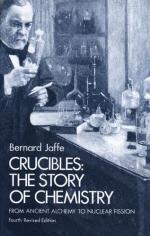|
This section contains 3,799 words (approx. 13 pages at 300 words per page) |

|
Nuclear fission is a process in which a heavy nucleus—usually one with a nucleon number of two hundred or more—separates into two nuclei. Usually the division liberates neutrons and electromagnetic radiation and releases a substantial amount of energy. The discovery of nuclear fission is credited to Otto Hahn and Fritz Strassman. In the process of bombarding uranium with neutrons in the late 1930s, they detected several nuclear products of significantly smaller mass than uranium, one of which was identified as 137Ba. The theorectical underpinnings that exist to this day for nuclear fission were proposed by Lise Meitner and Otto Frisch. Shortly after Hahn and Strassman's discovery.
Some heavy nuclei will fission spontaneously. Others can be induced to fission through interaction with a neutron. In both spontaneous nuclear fission and induced nuclear fission the pool of neutrons and protons is conserved. For example, the nucleus...
|
This section contains 3,799 words (approx. 13 pages at 300 words per page) |

|


